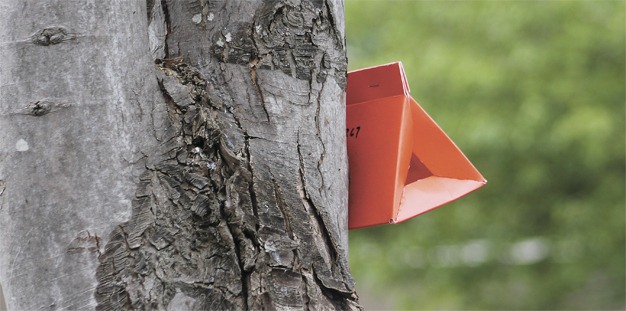Islanders may have noticed bright orange or neon green triangle-shaped boxes hanging from Island trees. The tiny boxes are gypsy moth traps, part of the Washington State Department of Agriculture’s (WSDA) program to prevent the infestation of gypsy moths.
These moths are some of the worst pests in the United States and are well established in 19 eastern and upper Midwestern states. They cause extensive environmental and economic costs every year, destroying crops, timber and wildlife habitats.
“It isn’t native to the U.S., so it doesn’t have any enemies,” said Mike Louisell, public information officer at the WSDA.
The two varieties of gypsy moth are European and Asian. The European moths are established in the east and Midwest, but the Asian moths are a greater threat to Washington state’s environment because they can eat evergreen trees, and females can fly. Thus, they would be much harder to contain than European moths. Fortunately, Asian gypsy moths do not have a foothold in the United States.
The WSDA has kept the gypsy moth population in check since 1974 and has prevented a major outbreak in the state.
“Small infestations do happen, but we’ve always been successful in eradicating them before they become a problem for damaging trees and vegetation,” Louisell said.
The triangle-shaped traps, which are either bright orange or bright green, hang on trees and shrubs across the state. This year’s trapping began in early July. Workers check the traps every two to three weeks and monitor the number of moths that have been caught. The trap releases a sex pheromone that attracts male moths, and if they follow the scent, they fly inside the trap and get stuck to the walls. Entomologists determine if it is a gypsy moth, and trappers may put out more traps to pinpoint the location of a possible infestation. The traps will be taken down in October for further research.
“It’s an early warning detection measure to increase awareness about reproducing populations,” Louisell said.
Only two moths have been found so far this summer, in the Skyway area in Renton. None have been found on Mercer Island. Last year’s total state count was 16, with 13 of those in Pierce County. Gypsy moths can get here from their established states if a resident moves and the moth eggs are attached to a car or barbecue. The egg masses found in Pierce County were sprayed with biological insecticide before the caterpillars could become moths.
“The program protects the agricultural reputation of Washington state,” Louisell said.
For more information, visit www.agr.wa.gov.



